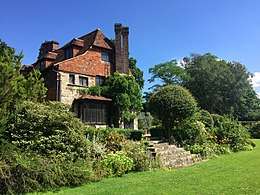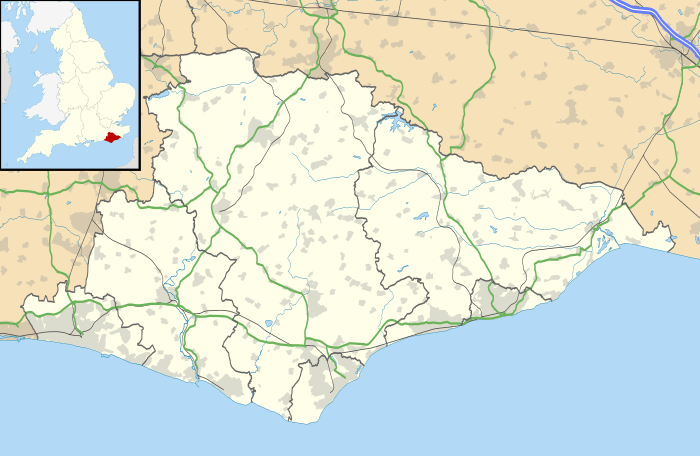Luxford House
Luxford House is a 16th-century Grade II listed building near Crowborough, East Sussex.[1] It is near the 11.5-acre (4.7 ha) Luxford Farm.[2] It was used by several rock musicians in the 1970s under the guidance of Tony Stratton Smith.
| Luxford House | |
|---|---|
 South elevation | |
| Location | Crowborough |
| Coordinates | 51°02′39″N 0°10′23″E |
| OS grid reference | TQ 52433 29432 |
| Area | East Sussex |
| Built | 16th century |
Listed Building – Grade II | |
| Official name: Luxford House | |
| Designated | 26 November 1953 |
| Reference no. | 1028448 |
 Location of Luxford House in East Sussex | |
History
Luxford house was constructed in the early 16th century as a smoke bay house.[3] During the 1930s it was bought by Sir Hugh Beaver, former Ministry of Works director general and founder of the Guinness Book of Records, who renovated and extended it.[4][5] It was Grade II listed on 26 November 1953.[1]
Following Beaver's death in 1967, ownership of the house passed to his daughter Cerise and son-in-law, Rev Christopher Lawson-Tancred.[6] It was let to rock music manager Tony Stratton Smith who lived there through the early 1970s.[4] He encouraged groups signed to his label, Charisma Records, including Genesis and Van der Graaf Generator, to rehearse there.[4]
Genesis wrote their 1971 album Nursery Cryme at Luxford House that summer.[4] A picture of Van der Graaf Generator taken at the house appeared on the inner gatefold sleeve of their 1971 album Pawn Hearts,[7][8][9] and the cover of Neil Diamond's album Stones also uses a picture taken on the property—of a stone wall—as its cover.[4] Bert Jansch recorded his 1974 album L.A. Turnaround at Luxford House, using the library as the live room, and made a promotional video featuring the premises.[6]
In December 2017, the property and estate was put on the market.[6]
Architecture
Luxford house is set in a 4,500 square feet (420 m2) estate with several lawns and gardens. The house features six bedrooms and a gym/studio constructed of Wealden stone.[6]
The exterior is timber-framed with plaster infilling, supported by a set of diagonal braces on the first floor and covered with a tile roof.[1]
References
- Historic England. "Luxford House (1028448)". National Heritage List for England. Retrieved 6 June 2020.
- "Description of 11 luxury homes in West Kent and East Sussex". Kent and East Sussex Courier. 19 January 2015. Retrieved 1 July 2015.
- Martin, D. (2005). "Institute of Archaeology, Project Ref 2060, Report Number 1561". Cite journal requires
|journal=(help) - Lucking, Liz (24 November 2017). "English Country House With Musical Connections Heads to Auction". Mansion Global. Retrieved 29 March 2020.
- "A Tutor house of rock and pop". The Times. 27 January 2017. Retrieved 6 June 2020.
- "Bid for a slice of music history at auction this December". Austin Gray. 23 November 2017. Retrieved 6 June 2020.
- Easlea, Daryl (2013). Without Frontiers: The Life & Music of Peter Gabriel. Music Sales Limited. p. 63. ISBN 978-0-857-12860-7.
- Christopulos, Jim; Smart, Phil (2005). Van der Graaf Generator – The Book. Phil and Jim Publishers. p. 122. ISBN 978-0-955-13370-1.
- Pawn Hearts (Media notes). Charisma Records. 1971. CAS 1051.